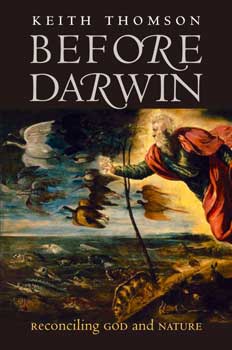
Before Darwin: Reconciling God and Nature by Keith Thomson, Yale University Press, New Haven, 2005; ISBN 0330107935, 314 pages, hardback, $27.00.
This absorbing history of ideas puts a human face on two centuries of struggle to understand nature scientifically, religiously, and philosophically, ending its survey with the Oxford debate on Darwin's ideas in 1859. The focus is natural theology, "the last great attempt to find a comprehensive answer to the question 'Does God exist and what is his nature?' through the objective, empirical methods of science rather than through revelation, biblical exegesis or the inspiration of God's vicars on earth" (p. 279). This theological approach can be traced back to St. Thomas Aquinas in the 13th century, and it continues today as Creation Science.
Dr. Thomson is professor emeritus of natural history at Oxford and a senior research fellow of the American Philosophical Society. Beginning with Copernicus, Galileo, and Newton, he traces the ways in which major clerics, scientists, and philosophers — largely from Britain — related growing empirical data about the natural world to theology. Ideas of John Ray, Robert Hooke, David Hume, Erasmus Darwin, and Thomas Malthus, among many others, are examined sympathetically but critically, and placed within the context of an ongoing debate about the world and God. Many of the arguments and accommodations between scientific data and theology covered here continue to play a leading part in debates about intelligent design and Creationism.
The book's central figure, William Paley, in 1802 published what is perhaps the definitive treatment of natural theology. Opening with the famous watch analogy for the argument from design, his Natural Theology relies on logical argument and empirical evidence, not scripture or miracles, to prove the existence and nature of God. Dr. Thomson summarized Paley's purpose:
All the patterns, symmetries and laws of nature were simply the reflection of God's mind. Therefore to study nature was to approach closer to God. Indeed, the deepest study of nature would provide confirmation of God's very existence. Natural science and theology were not at odds, therefore, but complementary. In particular, any kind of evolutionary theory of the kind that had been growing for the previous hundred years . . . would be negated. — p. 6
Before the 1800s most Western intellectuals, like the general population, assumed the earth and all its lives were created by God several thousand years ago, over the course of only a few days and principally for man's benefit. By the 1600s a growing interest in nature, combined with careful cataloging of observations in the field and through telescope and microscope, revealed evidence of complexity and adaptation. While this data was used by the devout as evidence of a purposeful creative intelligence behind nature, it also raised difficult questions. For example, how did the regularity of natural law fit with divine intervention? If each species was created perfect by God at the earth's beginning, how does one explain hybridization and evidence of the development of new species? And what about extinction, an issue raised by fossils? Most early fossils were shells, and pioneering naturalist Robert Plot (1641-1696) voiced a common skepticism of extinction when he doubted "whether it be likely that Providence, which took so much care to secure the Works of the Creation in Noah's Flood, should either then, or since, have been so unmindful of some Shell-Fish (and no other Animals) as to suffer any one Species to be lost" (pp. 125-6). Even in the opening years of the 19th century Thomas Jefferson "was unwilling to accept the concept of extinct animals. One of the non-political aims of the Lewis and Clark expedition was to search for the relict populations of mastodons in the far American West" (p. 135). Fossils were also key to geological evidence for a very ancient earth that had undergone waves of evolutionary development, the topic that generated strongest debate about the truth of biblical literalism among scholars and the public.
Over the course of the book Dr. Thomson explains basic ideas about evolution, their philosophical and evidential underpinnings, and how they developed. Modern evolution centers on the idea "that life has changed over time, and that the course of change has been one of diversification so that all extinct and living organisms are related by descent from common ancestors. The fact that life on earth (like the earth itself) has changed over time, in consistent patterns, is quite independent of any theory about the causes of change . . ." (p. 202). He also emphasizes the iconoclastic role of science:
Under science little stays the same. That is why it is so threatening to religious belief and socio-political authority. Science produces facts and laws but at its heart are questioning, testing and experiment, finding new explanations for old phenomena, finding new phenomena for old explanations, changing ideas and changing certainties. Religion, in contrast, is principally built upon certainties, authority and stability. 'A mighty fortress is our God' — a fortress against the surges of change that science and philosophy and, above all, independent thinking generate. . . .
In principle, science owes allegiance to no higher authority; . . . But orthodoxy, whether religious or political (or indeed scientific), depends upon commonly received opinions and often makes it heretical or treasonous to think otherwise. — pp. 22-3
For this reason, he believes, "most societies had previously kept literacy and learning for a very few, with only the controlling seers being allowed to contemplate the eternal mysteries" (p. 44).
Those interested in a historical presentation of issues raised by the evolution/creation debate will enjoy this beautifully-written book. — Louis A. Kirby
(From Sunrise magazine, December 2005/January 2006; copyright © 2005 Theosophical University Press)
Belief is thought at rest. — Charles S. Peirce